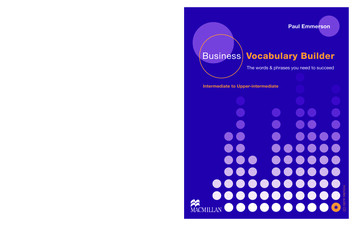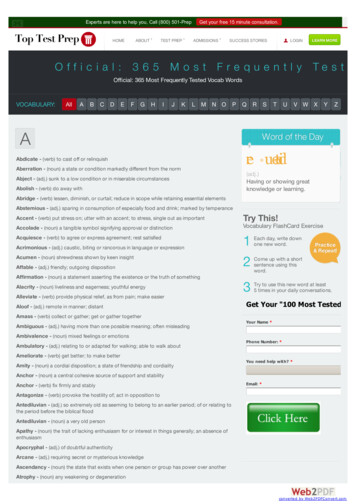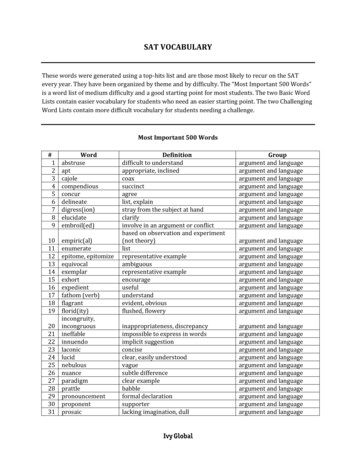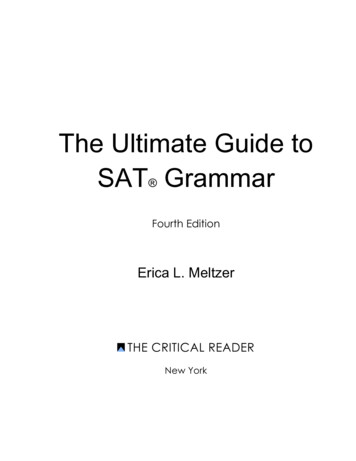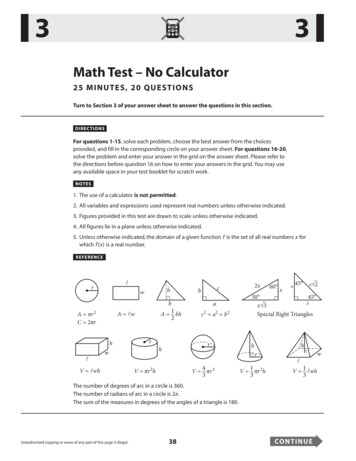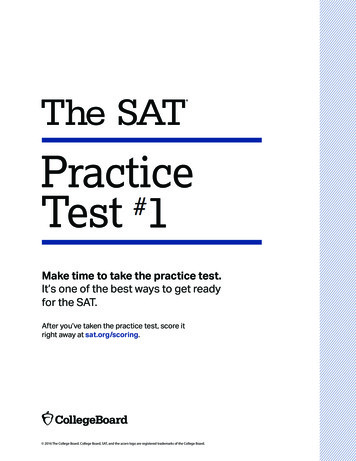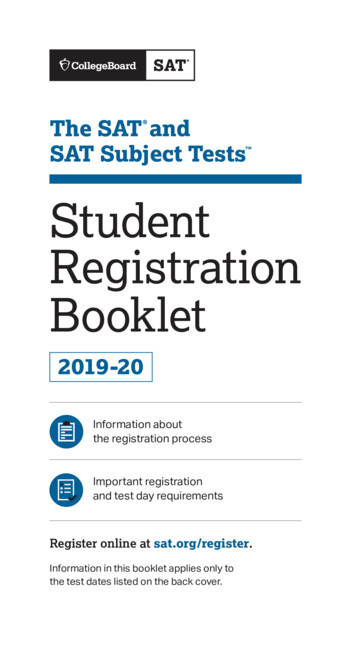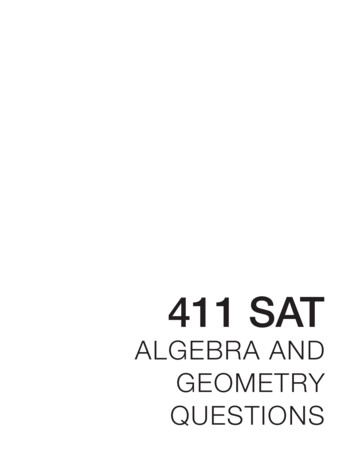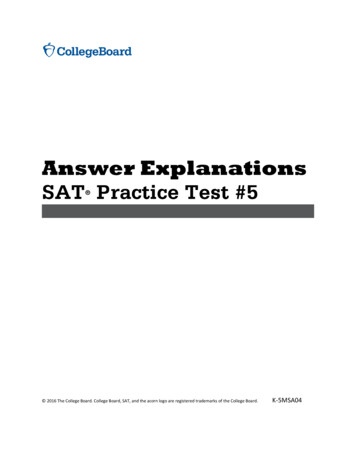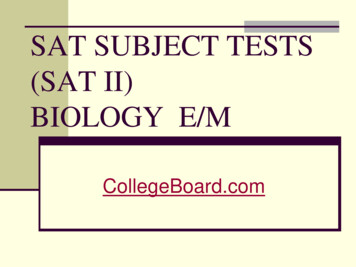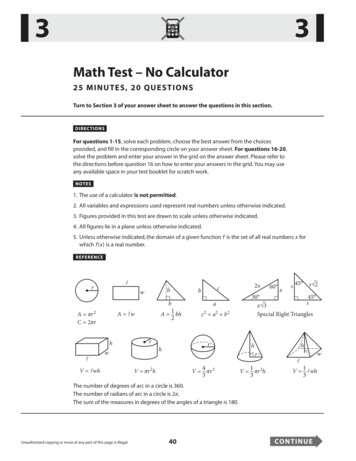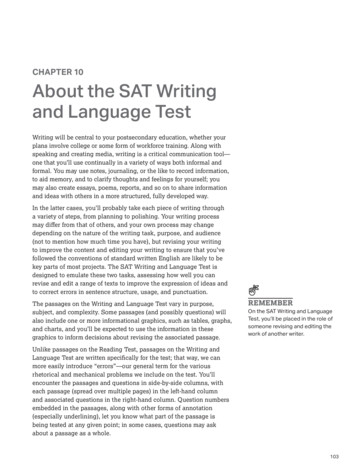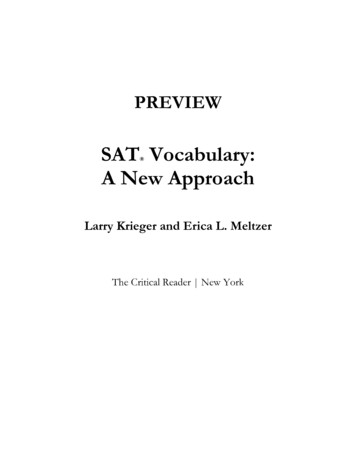
Transcription
PREVIEWSAT Vocabulary:A New Approach Larry Krieger and Erica L. MeltzerThe Critical Reader New York
PREVIEW - SAT VOCABULARY: A NEW APPROACHCopyright 2017 Larry Krieger and Erica L. MeltzerAll rights reserved.No part of this publication may be reproduced in any form or by any means, electronic ormechanical, including photocopy, recording, or any information storage and retrieval system, withoutwritten permission from the authors. For information, please send correspondence tothecriticalreader1@gmail.com.SAT is a trademark registered by the College Board, which is not affiliated with, and does notendorse, this publication.ISBN-13: 978-0-9975178-4-2ISBN-10: 09975178402Krieger & Meltzer
PREVIEW - SAT VOCABULARY: A NEW APPROACHTable of ContentsIntroduction4Part I: Reading1.Vocabulary in Context62.Passage-Based Vocabulary31Part II: Writing3.Commonly Confused Words544.Transitional Words and Phrases83Part III: The Essay5.Key Essay Vocabulary108Works Cited120About the Authors1233Krieger & Meltzer
PREVIEW - SAT VOCABULARY: A NEW APPROACHIntroductionA short time ago, in a galaxy not too far away, students just like you took a college admissions examfeaturing “obscure” words like vitriolic, sardonic, and vituperative. An organization called ETS testedthese words on questions called sentence completions, and teachers and tutors around the worldfinished each lesson by earnestly urging their students to “study your vocabulary.” Then, somethingextraordinary occurred. The College Board decided to write the SAT itself and promptly announcedthat these so-called obscure words and sentence completions would be banished from the SAT.Students cheered and stopped studying long lists of vocabulary words.These celebrations, however, seem to have been premature. While the College Board did banish allof the sentence completions and traditional vocabulary words, it replaced them with a new set ofwords—one that was not necessarily less challenging. As we have discovered, many students areuncertain about the meaning of words such as underpinning and phrases such as arrant purposelessness.And that in turn led us to ask a question: exactly what role does vocabulary play on the new SAT?This question prompted us to launch an exhaustive (and exhausting) analysis of vocabulary on boththe new Reading Test and the new Writing and Language Test. We also took a close look at the newEssay. Our analysis revealed that vocabulary continues to play a significant role on the exam.However, that role is subtler than it was on the old SAT. Instead of being concentrated in 19sentence completions and a handful of vocabulary-in-context questions, the new SAT vocabularytakes a variety of different forms.Our findings convinced us that the new SAT requires a new approach to vocabulary. In the past,SAT prep books featured long lists containing hundreds of alphabetized words. This book does notdo that. Instead, we have devoted a chapter to the following four specific types of assage-Based VocabularyCommonly Confused WordsTransitional Words and PhrasesEach chapter provides carefully sequenced sets of guided and independent practice questions,followed by detailed explanations.We conclude this book with a special section on the new SAT Essay. Although this part of the test isoptional, a majority of students are choosing to write it. In addition to providing a general templatefor constructing a strong five-paragraph essay, we provide students with specific examples of how touse effective transitions and a strong descriptive vocabulary to achieve a high Writing score. Thechapter concludes with a student essay that earned a top score of 24 on an actual exam.We have written this book with two main goals. First, we strive to present an enjoyable andstimulating course. And second, we strive to teach content and skills that will help all students excelon the SAT.Good luck on your exam!Larry Krieger and Erica MeltzerFebruary 20174Krieger & Meltzer
PREVIEW - SAT VOCABULARY: A NEW APPROACH1. Vocabulary in ContextVocabulary-in-context questions appear on the SAT Reading Test. They are designed to gauge yourability to use contextual clues to determine the meaning of a word or phrase that has multipledefinitions, or that is being used in an unusual way within a passage.You can essentially think of vocabulary-in-context questions as a matching game. The passage willcontain key words or phrases that correspond to one of the answers among the choices; your job isto connect those key elements of the passage to the correct answer.These questions make up a significant portion of the exam—approximately 15%. You can assumethat your test will include between seven and nine of them, representing a total of about 50 points onthe 800-point scale. Because they appear so often, you must have a clear plan for working throughthem. We’ll go into specific strategies later, but first, let’s look at what these questions involve.The good news is that vocabulary-in-context questions are always phrased the same way: As used in line x, “common” most nearly means These questions are guided by one major principle: context determines meaning.In some cases, that meaning will be reasonably close to a word’s literal or most frequently useddefinition. In other cases, however, it may be entirely different. As a result, you should be careful notto make too many assumptions based on what a word typically means.Let’s start by considering the meaning of the word common in the context of the following sentence:She didn’t see herself as a hero but simply as a common citizen.Since the sentence tells us that the woman didn’t see herself as a hero, we are looking for a definitionof common that means the opposite of “hero.” Within the context of this sentence, common means“ordinary”, its usual definition.Now, consider the meaning of the word yield in this short passage:The launch of a sustained program to develop green alternatives such as wind and solarpower will yield numerous benefits. It will end our dangerous dependence upon importingoil from nations that are often hostile to our national interests and will spur economicgrowth by creating new industries and new jobs.If you’re accustomed to encountering the word yield in a driving context, your first instinct might beto associate it with letting someone else go ahead of you. However, that meaning doesn’t make sensehere. Rather, the phrases numerous benefits and spur economic growth indicate that this word has a muchmore positive connotation here. It must mean something like “create.”6Krieger & Meltzer
PREVIEW - SAT VOCABULARY: A NEW APPROACHAlthough vocabulary-in-context questions focus on common, everyday words, they can also besurprisingly subtle and tricky. As a result, you should not underestimate them. In some cases, theanswer choices may consist of four relatively similar words, in which case you will need to distinguishvery carefully among them in order to determine the correct option.Another challenging aspect of studying for vocabulary-in-context questions is the fact that they tendto be quite random. Unfortunately, there is no set list of words from which questions are repeatedlydrawn. (That said, we have included a list of words commonly used in their second meanings at theend of this chapter). The good news is that there are a number of strategies that can help you workthrough these questions effectively and minimize the chance that you will second-guess yourself.Recognizing Context CluesAlthough it might seem obvious, the “context” aspect of vocabulary-in-context is absolutely key toapproaching these questions. More than anything, the ability to identify context clues will help youunderstand what type of word you are looking for and prevent you from getting sidetracked—eitherby meanings you normally associate with a word or by plausible-sounding distractors that don’t quitefit the definition required by the passage.So how do you know what to focus on? Let’s look at some examples.Example #1Auto dealers in Hawaii support the transition torenewable energy, but they believe it will take amassive advertising campaign by the state toencourage people to buy vehicles powered by5 alternative fuels. Hawaii’s residents ranked second inthe nation in 2015 with 2.94 electric vehicles forevery 1,000 residents, just behind California,according to the U.S. Department of Energy. Incontrast, tackling the fossil fuels used in airplanes will10 have to wait. Hawaii lies nearly 2,500 miles from thecontinental United States, so air travel is critical tothe state’s tourism industry; however, long flightsrequire energy in a dense form that is currentlyonly available in fossil fuels.1 .As used in line 11, “critical” most nearly meansThe first thing to notice is that this question concerns a word located at the very end of the passage.As a result, you might not be quite sure where to look for clues. After all, the passage contains a fairamount of information, so the information you need could be located almost anywhere, right? Well,actually, probably not.In reality, clues to most vocabulary-in-context words will appear fairly close to the word itself:if not in the same sentence, then in the sentence before or after. Those are the sentences youshould plan to focus on, regardless of how long a passage is.In this case, what do we learn from the sentence in which the word critical appears? That Hawaii isnearly 2,500 miles from the continental U.S.7Krieger & Meltzer
PREVIEW - SAT VOCABULARY: A NEW APPROACHFurther StrategiesIn addition to using context clues, there are some additional strategies that can help you narrowdown answers and avoid getting distracted either by trick answers or by your pre-existing knowledge.1) Cross out the word in the passageIf you consistently get distracted by the usual meaning of the word in the passage, you may find ithelpful to take your pencil and quickly scratch that word out in your test. Removing it from your lineof vision will allow you focus on the meaning in context and override any existing associations.2) Plug in your own word and then find the answer that matchesThis is often a highly effective strategy, one that can help you rapidly zero in on the answer andprevent you from getting fooled by plausible-sounding but not-quite-right distractors.But a warning: in order for this strategy to be effective, you must work quickly. If you need morethan a few seconds, you’ll probably end up wasting too much time and overthinking things.The other potential stumbling block is that even if you supply an accurate synonym, the correctanswer may be just different enough that you have trouble connecting your word to the right answer.If you are generally a strong reader, however, this should not pose a serious problem.3) Play positive/negative, then plug inIf you can determine from context whether the word is positive or negative, you can sometimeseliminate an answer or two. You can then plug the remaining answers back into the sentence and seewhich one makes the most sense. In rare cases, you may even be able to eliminate three options andjump directly to the answer.This strategy is ideal for a question like Example #1 on p. 7. As we determined from the context(Hawaii lies nearly 2,500 miles from the continental United States, so air travel is critical to the state’s tourismindustry), the word critical must mean something like “important.” That’s clearly a positive word.Now, let’s just reconsider the answer choices on their own:A)B)C)D)insecure. (negative)weak. (negative)essential. (positive)resistant. (negative)The only positive option is essential, which is also the answer.4) Plug each answer choice into the sentenceIf playing positive/negative is not helpful way to approach a question, or you are having difficultyplugging in your own word, plugging each word into the passage is another way to prevent yourselffrom getting stuck. Frequently, you will be able to hear that a particular choice does not soundcorrect or have the proper meaning within the context of a sentence. The only potential downside isthat sometimes, as is true for #1, the right answer is not a word you would think to use. As a result,you might talk yourself out of choosing it because you think it sounds too odd.11Krieger & Meltzer
PREVIEW - SAT VOCABULARY: A NEW APPROACHNatural and Social Science PassagesEach science passage describes the aims, methods, and results of a scientific investigation. As a result,these passages and their accompanying questions all employ a distinctive vocabulary that focuses onthe language of evidence and experimentation.In the section below, we define 25 of these key words and illustrate how College Board test-writersuse and test them. We will also provide helpful tips that will enable you to save time by going directlyto the correct answer.1. Hypothesis – a proposed insight or explanationA hypothesis is a proposed insight that has not been tested or verified. Science passages typicallybegin with a hypothesis that is then revised, challenged, strengthened, and sometimes confirmed. Inone passage, for example, chemical ecologists hypothesized that enhancing the scent of Texas gourdflowers would attract more desired squash bees while repelling unwanted striped cucumber beetles.To their surprise, squash bees were indifferent to the fragrance-enhanced blossoms. This unexpectedfinding forced the chemical ecologists to revise their hypothesis.2. Empirical – derived from experiment and observationEmpirical evidence is data derived from experiments and observations rather than abstract theories.The chemical ecologists described in the previous example tested their hypothesis by conducting acarefully controlled experiment in which they collected empirical data from 168 Texas gourd vines.Scientists are reluctant to accept a hypothesis when empirical information is not available. Forinstance, a passage on the Higgs Boson explains that the scientific community initially rejectedHiggs’s ideas because they rested on speculation and not empirical evidence.3. Central claim – primary assertionCollege Board test writers frequently use the phrase central claim. This phrase appears often inquestions, which may ask you to identify a central claim supported by data in a table. Don’t let thisphrase confuse you. Central means “main” or “primary,” and a claim is an assertion. So a centralclaim the main argument or hypothesis discussed in a passage.4. Counterclaim – counterargumentA counterclaim is a counterargument made to rebut (argue against) a claim discussed previously inthe passage. Science passages often include a counterclaim posed by a dissenting scientist—that is, ascientist who rejects the main theory discussed in the passage. For example, in a passage about theorigins of tectonic plates, one geochemist contended that the rocks studied by other geochemistswere too old and deformed to provide reliable data.5. Hypothetical – theoretical, based on speculationHypothetical describes an idea or situation that only exists as a theoretical concept. For example,time travel is a hypothetical phenomenon: it could exist, but right now it is only possible in sciencefiction movies. Although they are not real, hypothetical situations can challenge scientists to explorenew hypotheses about puzzling natural phenomena.32Krieger & Meltzer
PREVIEW - SAT VOCABULARY: A NEW APPROACHCharacteristics of Correct Answers: Same Idea, Different WordsIdentifying correct answers is the only way to earn points on the Reading Test. So what are thecharacteristics of a correct answer? Let’s begin your quest for correct answers with the followingparagraph and question:The efforts by women to gain equality in thescientific workplace began in the early twentiethcentury. The women who began undertaking careersin science had little support from any part of the5 society in which they lived. They had to strugglealone against a male-dominated scientific community.Even talented female scientists were forced to acceptsubordinate roles as assistants in large bureaucraticorganizations. As a result, they had little voice in10 making key decisions.1 .What point does the author make about thestatus of aspiring female scientists in the earlytwentieth century?A) They were more ambitious than their malecounterparts.B) They had more rights than their malecounterparts.C) They depended upon men for their safety andjob security.D) They were forced to accept subordinate rolesas assistants.Did you have any trouble finding the correct answer? Probably not. Choice D) provides the correctanswer by giving you a direct quote from the passage.Now, reread the paragraph and answer the following question:The efforts by women to gain equality in thescientific workplace began in the early twentiethcentury. The women who began undertaking careersin science had little support from any part of the5 society in which they lived. They had to strugglealone against a male-dominated scientific community.Even talented female scientists were forced to acceptsubordinate roles as assistants in large bureaucraticorganizations. As a result, they had little voice in10 making key decisions.1 .What point does the author make about thestatus of aspiring female scientists in the earlytwentieth century?A) They were more ambitious than their malecounterparts.B) They had more rights than their malecounterparts.C) They depended upon men for their safety andjob security.D) They were compelled to accept inferior roles.As you can see, the question here is identical to the one above, with the exception of Choice D).Although choice D) is worded differently, it is still correct. The phrase compelled to accept inferior roles isa restatement of the textual statement forced to accept subordinate (see Word #26) roles as assistants.Compelled forced, inferior subordinate. Same idea, different words.The Golden Rule: The Answer is in the PassageThe example above illustrates an extremely important rule: every SAT Reading Test question has justone objective answer that restates relevant ideas or information from the passage. Always rememberthis golden rule when you are answering passage-based questions: the answer is the answerbecause it is supported by the passage. This support will take the form of key words, phrases, andexamples. Never, ever go outside the passage to find support for your answers.41Krieger & Meltzer
PREVIEW - SAT VOCABULARY: A NEW APPROACHEvidence-Based Pairs: IntroductionThe SAT Reading Test now includes a significant number of new combination questions known asEvidence-Based Pairs. The pair begins with a normal question asking you about an aspect of thepassage. It is followed by a question that always asks, Which choice provides the best evidence for the answer tothe previous question? The four answer choices consist of quotations from the passage, one of whichwill contain the information necessary to answer the first question.Each Reading Test passage includes one and usually two sets of Evidence-Based Pairs. Our analysisof these questions indicates that they are in fact a subtle and sophisticated way to test your ability toidentify and understand the meaning of selected vocabulary words. These paired questions offer youboth rewards and risks. If you understand and recognize the key vocabulary words, you can easilyadd two points to your raw score. However, if you misunderstand the questions you risk losing bothpoints. Don’t worry! We have devised a three-step strategy designed to help you master theEvidence-Based Pairs.Let’s look at an example:Political scientists have carefully studied theimpact of Dr. King’s life and speeches on publicattitudes towards civil rights. The opening of theMartin Luther King, Jr. Memorial in Washington,5 D.C., on August 22, 2011 provided an excellentopportunity to continue this investigative tradition.Thousands of people visit the memorial each day topay tribute to Dr. King and to honor his vision of ajust society. After admiring the thirty-foot statue of10 Dr. King, most visitors stand in front of theInscription Wall and reverently read the inscribedexcerpts from his most inspiring sermons and publicaddresses. Our team of public opinion experts begantheir research by interviewing a random selection of15 visitors to gauge how visiting the memorial affectedtheir view of civil rights in America.1 .The passage indicates that visitors approachDr. King’s words with an attitude ofA)B)C)D)detached indifference.open disapproval.quiet skepticism.great admiration.2 .Which choice provides the best evidence for theanswer to the previous question?A)B)C)D)Lines 1-3 (“Political rights”)Lines 3-6 (“The opening tradition”)Lines 9-13 (“After addresses”)Lines 13-16 (“Our America”)Step 1: Begin by carefully determining what the first question is asking. The key word attitude tellsyou what to look for in the passage.Step 2: Next, read each of the four sentences referenced in the answer choices. As you read eachchoice, look for a key word or phrase that describes the “attitude” of visitors as they approached Dr.King’s famous words. The key word reverently clearly describes their attitude.Step 3: Now match the meaning of reverently with one of the answer choices in the first question. Asyou learned in our list of vocabulary words, reverently (see Word #34) means “with great admiration.”You have a match! The answers to our two questions are D) and C).45Krieger & Meltzer
PREVIEW - SAT VOCABULARY: A NEW APPROACH3. Commonly Confused Words“The difference between the almost right word and the right word is really a large matter. ’tis the difference between thelightning bug and the lightning.”-Mark TwainThere’s no question that English can be very tricky sometimes. It’s filled with homophones—wordsthat have slightly different spellings but that are pronounced similarly or identically. When peoplespeak quickly, as is often the case in everyday conversation, these words can be impossible to tellapart. But while errors can easily be hidden in speech, they are far more apparent in writing.For example, take a look at the following paragraph:Before the first transatlantic cables were manufactured, communication betweenNorth America and Europe was limited. Accept for ships, which took weeks to cross theocean, there was no way to relay messages between continents. Making matters worse,severe winter storms could have an averse affect on correspondence, delaying ships forweeks and depriving individuals and companies of excess to family members and businessassociates. Five attempts to lay a cable were made between 1857 and 1866, but workerswere unable to make all of the pieces cohere to the bottom of the ocean; there was alwaysapart that broke away. In 1866, however, a lasting connection was finally achieved. Thenew cable immediately effected communication times, assuring that people could send amessage and receive a response the same day.Did you notice anything odd as you read this paragraph? It includes a number of commonlyconfused words tested on recent (P)SATs. Don’t worry if you looked past them—that’s the point!Now take a look at the corrected version:Before the first transatlantic cables were manufactured, communication betweenNorth America and Europe was limited. Except for ships, which took weeks to cross theocean, there was no way to relay messages between continents. Making matters worse,severe winter storms could have an adverse effect on correspondence, delaying ships forweeks and depriving individuals and companies of access to family members andbusiness associates. Five attempts to lay a cable were made between 1857 and 1866, butworkers were unable to make all of the pieces adhere to the bottom of the ocean; therewas always a part that broke away. In 1866, however, a lasting connection was finallyachieved. The new cable immediately affected communication times, ensuring thatpeople could send a message and receive a response in same day.The good news is that you’ll never see anything like this example on the (P)SAT. You will encounterno more than two questions testing this concept on the Writing test. More good news: the SAT oftentests the same limited group of homophones over and over again. If you want to be prepared andnot risk losing easy points, however, you must be familiar with the top contenders for this error.54Krieger & Meltzer
PREVIEW - SAT VOCABULARY: A NEW APPROACHAffect vs. EffectOf all the word pairs tested on the SAT, affect vs. effect tends to give students the most trouble. Sonaturally College Board test writers devote a number of questions to this troublesome pair of words.But don’t worry! This section will help you ace affect vs. effect questions.Affect is a verb meaning “to influence or have an impact on something.” For example, the forecastfor a big winter storm affected the plans of people throughout the entire metropolitan area.Effect is usually a noun* meaning “the result or consequence of something.” If a/an/the appearsbefore the word, the answer is effect. Effect is often followed by on because things have “an effect on”other things. For example, the Boston Tea Party had an immediate effect on relations between thecolonies and Great Britain; it was effective (adjective form of effect) in getting the King’s attention.Although these words can be very confusing, you can also use the following mnemonic trick to helpyou keep them straight. Think RAVEN: Remember Affect is a Verb and Effect is a Noun.Guided Practice:Example #1Incorrect:The accumulation of oxygen in the atmosphere effects the amount of sunlightthat reaches the ground.Correct:The accumulation of oxygen in the atmosphere affects the amount of sunlightthat reaches the ground.The subject of this sentence is the accumulation of oxygen. Note that affect is a verb since the accumulation ofoxygen affects.Example #2Incorrect:The accumulation of oxygen in the atmosphere has an affect on the amount ofsunlight that reaches the ground.Correct:The accumulation of oxygen in the atmosphere has an effect on the amount ofsunlight that reaches the ground.Effect is correct because an must come before a noun, and the word in question is followed by on.Example #3Classical computers encode information as bits that can be in one of two states: zero orone. In contrast, quantum computers are composed of “qubits” that can be in both statessimultaneously. These qubits have the [effect/affect] of allowing computers to essentiallyperform many calculations at once.Because the appears before the word, a noun is required. Effect is therefore the only possible answer.*Note: There are situations in which affect is used as a noun and effect as a verb, but the College Board isnot interested in testing these exceptions, and they should not be a concern for you here.55Krieger & Meltzer
PREVIEW - SAT VOCABULARY: A NEW APPROACH4. Transitional Words and PhrasesHow many times have you used the words for example and however in your essays for school? Mostwriters use these common words on a regular basis. Now let us ask you another question: How manytimes have you used the words in fact, conversely, and consequently in your essays? You probably use thesewords a lot less frequently than you use for example and however.For example, however, in fact, conversely, and consequently are all transitional words. A transition is a changeor shift, and that is exactly the function these words perform in a sentence. They signal a change or ashift in an author’s presentation of thoughts.College Board test writers are aware of the important role transitional words play in good writing.That’s why the SAT Writing and Language test typically includes 4-6 questions designed to test yourunderstanding of transitional words and phrases.We have good news and bad news about transitional words. The good news is that the College Boarddraws its correct answers from a pool of only about 25 words. The bad news is that you must have aprecise understanding of what these words mean and how they are used in a sentence.Dwayne “the Rock” Johnson to the RescueIs it possible for Dwayne “the Rock” Johnson to help you deliver a “people’s elbow” to the SATtransitional questions? At first glance, this is an absurd question. After all, Johnson is a formerwrestling champion and a current action adventure movie star. Wouldn’t a detailed glossary of termsbe more helpful than the Rock’s “people’s elbow?” Before you dismiss Johnson as an irrelevantdistraction, bear with us and read the following passage about him.Dwayne “The Rock” Johnson is now one of the world’s best-known and most highlypaid celebrities. He is a former WWE wrestling champion and a star in the hugelysuccessful Fast and Furious movie franchise. In addition, People Magazine named Johnson2016’s “World’s Sexiest Man.”Success has not always come easily to Johnson. As a promising football player at theUniversity of Miami, Johnson hoped to have a professional career playing in the NFL.However, an injury ended his dream and left him dejected and impoverished. “I lookedin my pocket,” Johnson remembers, “and I had seven bucks to my name.”Today, Johnson oversees an entertainment company appropriately named Seven BucksProductions. He is busy writing a second autobiography, preparing new movie projects,and creating a YouTube channel. Johnson’s popularity is soaring. He is a charismaticentertainer with a global reach that extends to more than 100 million followers on variousplatforms. Accordingly, Johnson is now shifting his attention to foreign markets becausehe knows the pivotal role they play in the successful career of a contemporary movie star.83Krieger & Meltzer
PREVIEW - SAT VOCABULARY: A NEW APPROACHThe short passage on the previous page contains interesting details about Johnson’s career. Eachparagraph features a key transitional word that directs the flow of ideas. In the first paragr
the new Reading Test and the new Writing and Language Test. We also took a close look at the new Essay. Our analysis revealed that vocabulary continues to play a significant role on the exam. However, that role is subtler than it was on the old
